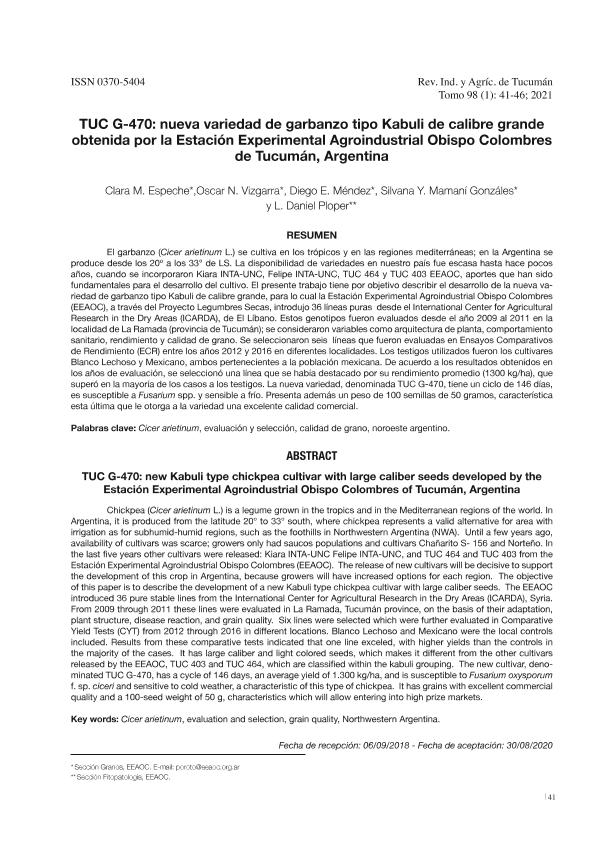Artículo
El garbanzo (Cicer arietinum L.) se cultiva en los trópicos y en las regiones mediterráneas; en la Argentina se produce desde los 20º a los 33° de LS. La disponibilidad de variedades en nuestro país fue escasa hasta hace pocos años, cuando se incorporaron Kiara INTA-UNC, Felipe INTA-UNC, TUC 464 y TUC 403 EEAOC, aportes que han sido fundamentales para el desarrollo del cultivo. El presente trabajo tiene por objetivo describir el desarrollo de la nueva variedad de garbanzo tipo Kabuli de calibre grande, para lo cual la Estación Experimental Agroindustrial Obispo Colombres(EEAOC), a través del Proyecto Legumbres Secas, introdujo 36 líneas puras desde el International Center for Agricultural Research in the Dry Areas (ICARDA), de El Líbano. Estos genotipos fueron evaluados desde el año 2009 al 2011 en la localidad de La Ramada (provincia de Tucumán); se consideraron variables como arquitectura de planta, comportamiento sanitario, rendimiento y calidad de grano. Se seleccionaron seis líneas que fueron evaluadas en Ensayos Comparativosde Rendimiento (ECR) entre los años 2012 y 2016 en diferentes localidades. Los testigos utilizados fueron los cultivares Blanco Lechoso y Mexicano, ambos pertenecientes a la población mexicana. De acuerdo a los resultados obtenidos en los años de evaluación, se seleccionó una línea que se había destacado por su rendimiento promedio (1300 kg/ha), que superó en la mayoría de los casos a los testigos. La nueva variedad, denominada TUC G-470, tiene un ciclo de 146 días, es susceptible a Fusarium spp. y sensible a frío. Presenta además un peso de 100 semillas de 50 gramos, característica esta última que le otorga a la variedad una excelente calidad comercial. Chickpea (Cicer arietinum L.) is a legume grown in the tropics and in the Mediterranean regions of the world. In Argentina, it is produced from the latitude 20° to 33° south, where chickpea represents a valid alternative for area with irrigation as for subhumid-humid regions, such as the foothills in Northwestern Argentina (NWA). Until a few years ago, availability of cultivars was scarce; growers only had saucos populations and cultivars Chañarito S- 156 and Norteño. In the last five years other cultivars were released: Kiara INTA-UNC Felipe INTA-UNC, and TUC 464 and TUC 403 from the Estación Experimental Agroindustrial Obispo Colombres (EEAOC). The release of new cultivars will be decisive to support the development of this crop in Argentina, because growers will have increased options for each region. The objective of this paper is to describe the development of a new Kabuli type chickpea cultivar with large caliber seeds. The EEAOC introduced 36 pure stable lines from the International Center for Agricultural Research in the Dry Areas (ICARDA), Syria. From 2009 through 2011 these lines were evaluated in La Ramada, Tucumán province, on the basis of their adaptation, plant structure, disease reaction, and grain quality. Six lines were selected which were further evaluated in Comparative Yield Tests (CYT) from 2012 through 2016 in different locations. Blanco Lechoso and Mexicano were the local controls included. Results from these comparative tests indicated that one line exceled, with higher yields than the controls in the majority of the cases. It has large caliber and light colored seeds, which makes it different from the other cultivars released by the EEAOC, TUC 403 and TUC 464, which are classified within the kabuli grouping. The new cultivar, denominated TUC G-470, has a cycle of 146 days, an average yield of 1.300 kg/ha, and is susceptible to Fusarium oxysporum f. sp. ciceri and sensitive to cold weather, a characteristic of this type of chickpea. It has grains with excellent commercial quality and a 100-seed weight of 50 g, characteristics which will allow entering into high prize markets.
TUC G-470: Nueva variedad de garbanzo tipo Kabuli de calibre grande obtenida por la Estación Experimental Agroindustrial Obispo Colombres de Tucumán, Argentina
Título:
TUC G-470: New Kabuli type chickpea cultivar with large caliber seeds developed by the Estación Experimental Agroindustrial Obispo Colombres of Tucumán, Argentina
Espeche, Clara Marcela; Vizgarra, Oscar Niceforo; Mendez, Diego Eduardo ; Mamani Gonzales, Silvana Yacqueline
; Mamani Gonzales, Silvana Yacqueline ; Ploper, Leonardo Daniel
; Ploper, Leonardo Daniel
 ; Mamani Gonzales, Silvana Yacqueline
; Mamani Gonzales, Silvana Yacqueline ; Ploper, Leonardo Daniel
; Ploper, Leonardo Daniel
Fecha de publicación:
06/2021
Editorial:
Estación Experimental Agroindustrial Obispo Colombres
Revista:
Revista Industrial y Agrícola de Tucumán
ISSN:
0370-5404
e-ISSN:
1851-3018
Idioma:
Español
Tipo de recurso:
Artículo publicado
Clasificación temática:
Resumen
Archivos asociados
Licencia
Identificadores
Colecciones
Articulos(ITA-NOA)
Articulos de INST. DE TECNOLOG. AGROINDUST. DEL NOROESTE ARGENTINO
Articulos de INST. DE TECNOLOG. AGROINDUST. DEL NOROESTE ARGENTINO
Citación
Espeche, Clara Marcela; Vizgarra, Oscar Niceforo; Mendez, Diego Eduardo; Mamani Gonzales, Silvana Yacqueline; Ploper, Leonardo Daniel; TUC G-470: Nueva variedad de garbanzo tipo Kabuli de calibre grande obtenida por la Estación Experimental Agroindustrial Obispo Colombres de Tucumán, Argentina; Estación Experimental Agroindustrial Obispo Colombres; Revista Industrial y Agrícola de Tucumán; 98; 1; 6-2021; 41-46
Compartir



